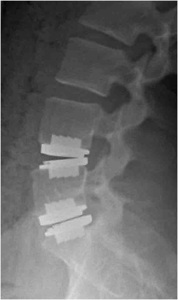Contact ☎ 310.448.7844
LUMBAR ARTIFICIAL DISC REPLACEMENT
Lumbar Artificial Disc Replacement is a technology designed to replace a symptomatic lumbar degenerated disc with a metal and plastic ball and socket prosthesis. A symptomatic disc is defined as causing low back (axial) or leg (radicular) pain with or without a functional or neurologic deficit. Examples of structurally degenerated discs are herniated nucleus pulposes (your classic ‘herniated disc’), mild instability on motion, loss of disc height or hydration of the disc (like a sponge drying out), and vacuum phenomenon (air in the disc).
The L-ADR is inserted through a front side (anterior) approach. It is implanted at the diseased level after the disc has been completely removed (total discectomy). The discectomy and removal of bone spurs will decompress the nerves. The implanted L-ADR will maintain the joint space height and potentially preserve motion at the surgically corrected level. This motion preservation may theoretically prevent or slow the progression of adjacent disc levels from degenerating.
Lumbar Artificial Disc Replacement
Case Study
Here we have an example of a patient who suffered from mainly back pain, with some leg pain, for several years. She failed conservative management in the form of physical therapy, spinal injections, oral medications, and activity modification. She underwent an artificial disc replacement at L4-5 and L5-S1. At two and a half year follow-up, her pain decreased from 8/10 pre-op to 0, and she was training for a half marathon.


